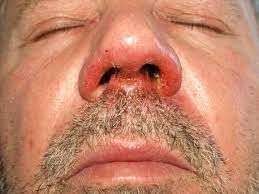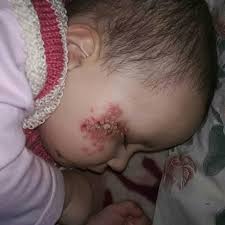Alefo in babies is one of the scary things a new mother faces and is seldom prepared for but often affects children. Although it can affect adults, it is more common in babies and toddlers. It is characterized by red sores forming on the skin, and these sores can get inflamed and filled with pus. When they burst, they form a crusted pustule on the skin, whose appearance can also be scary, especially if they are many. However, they are quite easy to treat and manage.
Quick Facts About Alefo (Impetigo)
Alefo, also called Eela is the Yoruba term for the English skin infection known as Impetigo. It is usually contacted through contact with an infected person, whether by sharing clothing such as towels, or simply through hugs. It can also occur when one stays in a crowded environment. Therefore, one of the ways to avoid alefo in babies is to avoid overcrowded places, and separate their clothing from other people’s.
In this article, we will understand the effect of alefo in babies and why you, as a new mother should not be so scared about it. We will also help you understand the cause of alefo in babies, and how you can successfully treat the sore and pustule with available materials.
Understanding Alefo in Babies
Impertigo as it is called in English is a highly contagious infection of the skin that affects both adults and children, even though it is more common in babies and toddlers. You might notice some reddish sores around your baby’s nose, face, and even buttocks. They may be itchy and after some days, they burst or rupture to form crusts. When the fluid from these sores touch other parts of the skin, another sore might develop there, thus, spreading further.
Alefo in babies is considered a more serious condition due to the supple nature of babies’ skins compared to an adult’s. Regardless, this skin infection is easy to treat, either with an antibiotic that must be completed or through some herbal concoction that are locally prepared for this purpose.
Causes of Alefo in Babies
Alefo in baies, and also in adults, is caused by bacteria. It could be either one of Staphylococcus or Streptococcus bacterium, and they take hold on children faster, due to their relatively weaker immunity compared to adults. These bacteria spread easily in places where there is overcrowding, especially if there is an infected person in the environment.

These bacteria can be present on clothing such as towels or napkins used for the babies, if they have been touched by an infected person. Once these materials, already carrying any of the bacteria, are used to wipe the child’s skin, it begins its effect on the skin, causing sore that later forms crusts on the skin.
It is also possible that alefo in babies begin from their creche or daycare centers, where other affected babies can spread it to other babies.
Also, warm and moist environments, such as in the tropics, are excellent breeding grounds for the bacteria. Therefore, it is best to make the environment for your baby, as uncomfortable for bacteria as possible.
Types and Symptoms of Alefo (Impetigo)
There are basically two types of Alefo that can occur on anyone’s skin. While they have similarities in some of their symptoms, they can be caused by different bacteria, and are contagious in different times. They are:
Non-bullous Impetigo
This is the most common type of alefo in babies, and it can be caused by both strep and staph bacteria. It starts off as a red spot that looks like an insect bite on the face, sometimes on the arms and legs, but quickly evolves into pustules that erupts and form a honey-colored crust.
Bullous Impetigo
This type of alefo in babies is caused by the staphylococcus bacteria and is mostly found on the buttocks. It causes a reduced adhesion between the layers of the skin – the dermis and epidermis stick less to each other, causing a blister. Due to the flimsiness of the blister, it erupts quickly, discharging its yellow fluid content and causing a thick-edged crust to form on the skin.
Treatment of Alefo in Babies
As is common for bacterial infections, alefo is usually treated using antibacterial. The most common form of antibacterial used for the treatment pf alefo in babies is the topical ointment. This type of antibacterial penetrates the skin, through the sore and kills off the bacteria underneath the skin of your baby.
However, the crust formed on the skin may be protective of the sore, and consequently, the bacteria. Therefore, you must remove the crust, to expose the sore.
You can soak a towel in warm water and place it over the crust. Leave it for a few seconds and wipe the sore down with the towel. The crust leaves the sore and you can easily apply the topical antibacterial ointment for better efficacy.
Also, your doctor might prescribe oral antibacterial for your child. Ensure that they use the complete dose for better treatment of the condition.
Alternative Treatment for Alefo in Babies
Apart from the use of oral antibacterial medication and topical creams and ointment, alefo in babies can be treated using herbs. The herbs used in this treatment usually have antibacterial properties. They include:
Ginger
Ginger is a common root that is filled with medicinal value. Among the many health benefits of ginger is its use as an antibacterial, according to this study. You cab use ginger to tackle impetigo but not in children, except their skin is known not to react to ginger.
Cut slices of ginger and place the inner surface over the sore. This will cause a sting but the introduction of its juice will help to kill of the causative agent. Alternatively, you can crush the ginger root and make it into a poultice, place it over the sore for some seconds.
Neem
Another herb that has antibacterial property is neem, scientifically called Azadiracta indica. Some people get the leaves of the plant, macerate it and apply it to the sores. However, you can use the oil gotten from the leaves as a topical ointment. Apply it over the sores and they will dry up in a matter of days.
Red Acalypha
Commonly called Jacob’s coat or copperleaf, red acalypha is an effective herbal medication against fungal and bacterial infections. It is made to be drunk as an herbal concoction, and its oil can also be extracted to make ointments that can be topically applied on the skin to address skin infections.

For treating alefo in babies, harvest a reasonable quantity of leaves, wash them and bring them to boil in a big bowl of water. Use the now red-colored water to bath your baby after you must have taken some to be drunk.
Alternatively, you can apply the red acalypha oil to the sores.
Conclusion
Alefo is a Yoruba word that literally means forms and bursts. This perfectly describes the action of impetigo or alefo in babies. The infected part of the skin gets inflamed, as though an insect bite was the cause. It grows as the liquid in it accumulates, and bursts to discharge its content and form a crust on the skin.
It is caused by staph and strep bacteria, and is usually spread by contact. It thrives in a warm and moist environment. However, it can be easy to treat, either through antibacterial tablets or capsules or through herbal medication.

Ayomide is a fiction and non-fiction writer. A lover of science and everything mysterious that surrounds it, he seeks out new information to keep his interest alive.
The content is intended to augment, not replace, information provided by your clinician. It is not intended nor implied to be a substitute for professional medical advice. Reading this information does not create or replace a doctor-patient relationship or consultation. If required, please contact your doctor or other health care provider to assist you to interpret any of this information, or in applying the information to your individual needs.






